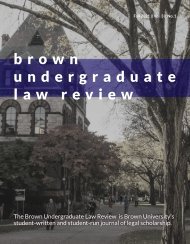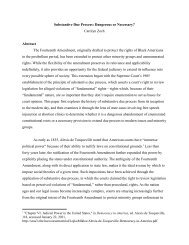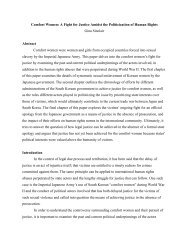From Frontiero to the Air Force: Citizenship and Equal Protection in U.S. Reproduction Jurisprudence
Olivia Siemens '21
Olivia Siemens '21
Create successful ePaper yourself
Turn your PDF publications into a flip-book with our unique Google optimized e-Paper software.
discrimination in commercial hiring practices; 20 struck down mandatory maternity leave
policies; 21 upheld equal pay requirements for male and female workers; 22 and certified the rights
of married and unmarried women alike to obtain access to contraception—all at least partially
under the auspices of the Equal Protection Clause—the Court has failed to apply these same
equal protection criteria to enshrine an equality-based constitutional right to abortion access. 23
Rather than acknowledging that abortion restrictions place an unconstitutional burden on the
participatory rights of female (though not male) citizens, the Court has opted to inject an air of
false gender neutrality into its abortion jurisprudence.
Abortion as Privacy
The Supreme Court first recognized a constitutional right to abortion in the 1973 case
Roe v. Wade. In a 7–2 decision, the Court struck down a Texas law that outlawed abortion in all
cases, except when it was medically necessary to save a woman’s life. The Roe majority located
the abortion right under the umbrella of the so-called “right of personal privacy”—a right which,
though never mentioned explicitly in the text of the Constitution, ostensibly emanates from the
First, Fourth, Fifth, Ninth, and Fourteenth Amendments. 24 Justice Harry Blackmun, writing for
the majority, argues:
This right of privacy, whether it be founded in the Fourteenth Amendment’s
concept of personal liberty and restrictions upon state action, as we feel it is, or as
the District Court determined, in the Ninth Amendment’s reservation of rights to
the people, is broad enough to encompass a woman’s decision whether or not to
terminate her pregnancy. 25
As a result of its recognition of these “broad enough” rights, the Court prohibited first-trimester
abortion restrictions but reserved the option for states to regulate abortions on a
“narrowly-tailored” basis after the “compelling” point of fetal viability. In effect, the Court
enacted a strict scrutiny standard for post-viability restrictions. 26
20
Phillips v. Martin Marietta Corp., 400 U.S. 542 (1971).
21
Cleveland Board of Education v. LaFleur, 414 U.S. 632 (1974); Craig v. Boren, 429 U.S. 190 (1976).
22
Corning Glass Works v. Brennan, 417 U.S. 188 (1974).
23
Eisenstadt v. Baird, 405 U.S. 438 (1972).
24
Roe v. Wade, 410 U.S. 113 (1973); Griswold v. Connecticut, 381 U.S. 479 (1965).
25
Roe, 410 U.S. 113.
26
Ibid.
8










